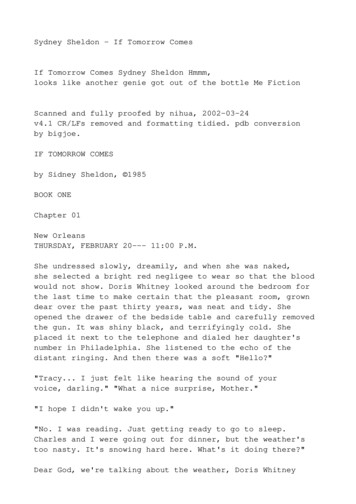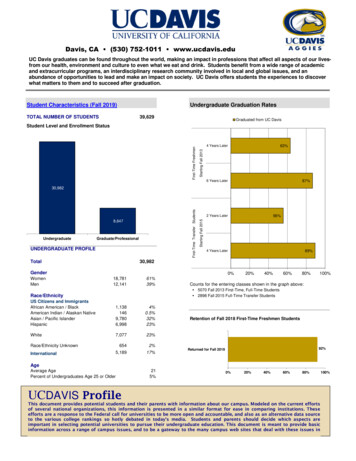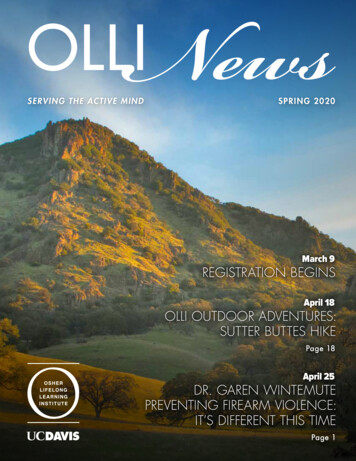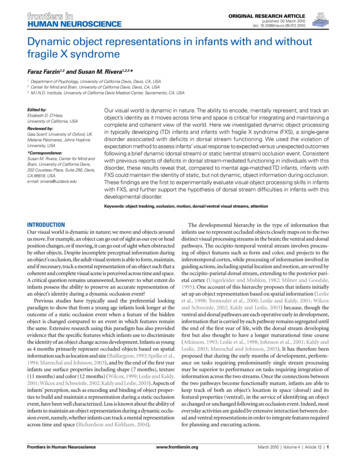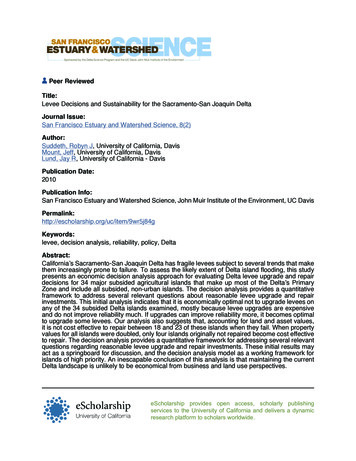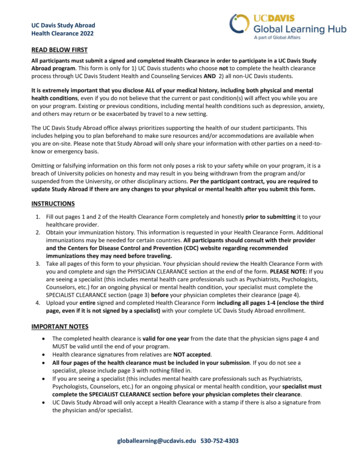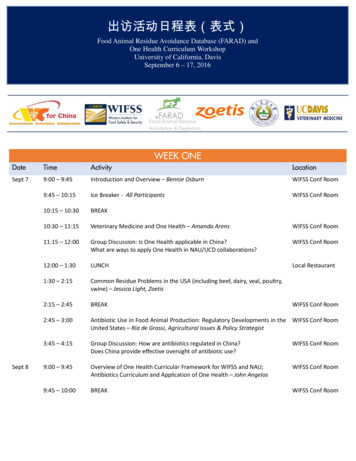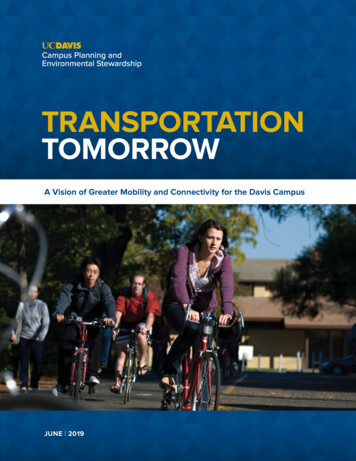
Transcription
TRANSPORTATIONTOMORROWA Vision of Greater Mobility and Connectivity for the Davis CampusJUNE 2019
Transportation Services, with a consulting teamled by Alta Planning Design, conducted atwo-year planning study charting a new wayforward towards a more sustainable future.This report summarizes that effort and the resultingtop ten recommendations. The goal is to creategreater mobility and connectivity for the Davis Campus.1
INTRODUCTIONBicycles and Unitrans are integral parts of theUC Davis experienceTransportation Tomorrow seeks to addressthose challenges.Pedaling bicycles around campus under theshade of heritage cork oaks has been a partof the UC Davis experience for more than fiftyyears. So has riding the bus to campus. Thisprogressive transportation culture is a corepart of the UC Davis experience, part of thestory the UC Davis community tells itself andothers. The transportation accomplishmentsof the past are, justifiably, a central part of theUC Davis identity.The backdrop for this project is a commitmentto bold action in the face of climate change.UC Davis has a history of taking principledpositions on sustainability issues. Today,global urgency around the need for climateaction is higher than ever. The UC SustainablePractices Policy declares that all campusesshould decrease greenhouse gas emissionsby reducing drive-alone commute trips byten percent by 2025. UC Davis takes thisresponsibility seriously and commits tomeeting or exceeding the UC Office of thePresident directive by 2025.Societal changes in housing patterns andtransportation behavior have begun tochallenge this legacy, and more challengesawait on the horizon. Complacency would bea mistake in the face of these challenges. Itis time for us to refresh that legacy, reinvestin our future, and write the next chapterin the history of UC Davis transportationinnovation. It is time for us to bolster oursupport for the health of our community andour environment.In 2015 only one-quarter of the UC Daviscommunity drove to the main campus. Thatfraction equates to about 10,000 peopledriving about 300,000 miles per day—fartherthan a trip to the moon. Based upon thistransportation pattern, we need 1,000 fewerpeople, or ten percent of those currentlydriving to campus each day, to meet our goals.“It is time for us to bolster our supportfor the health of our community andour environment.”2
“Our goal is to provide mobilityservices, not just parking.”If we own the challenge together, we couldask each driver to try an alternative twice amonth. When we all pitch in,the challenge becomes manageable.The path to success must respond to thisbaseline pattern as well as two additionalchallenges. Potential growth in the campuspopulation, as well as the significant numberof employees expected to retire in the nextten years, present significant challengesto the university in accomplishing oursustainable transportation goals. If UC Daviswere to take no steps to decrease driving, butinstead build enough parking to meet futuredemand, the overall costs would exceed 300 million. That cost would double or triplethe cost of a parking permit.Our goal is to avoid these costs and createa more sustainable future. TransportationTomorrow is the framework to accomplishour goals and create that future.Transportation Tomorrow will build uponthe legacy of sustainable transportationto create a future in which the universityprovides convenient, flexible, and equitabletransportation services for the campuscommunity for a fraction of the cost of3building new parking structures. Our goal is toprovide mobility services, not just parking.The ten recommendations withinTransportation Tomorrow were developedthrough two years of community engagementand technical analysis. They are groundedin the four factors that most influencetransportation choices: cost, culture,convenience, and the built environment,referred to as 3CBE.The engagement findings are describedin full detail in the TransportationTomorrow Engagement Summary. Therecommendations are described in greaterdetail in the accompanying TransportationDemand Management Technical Manual,which contains detailed implementationguidance for the institution.Reducing drive-alone commute trips by overten percent is a big undertaking. However,the UC Davis community has successfullyaccomplished audacious goals in the past.This community has the ingredients forsuccess: world-class academic leadership,a campus community that embraces activetransportation and transit, and past successesthat can be built upon. It’s time to get to work.
4
THE LEGACYUC Davis is a uniquely multimodal campus.Just one in four (25.3%) UC Davis affiliatesdrove to campus on a regular basis in 2015.Forward-thinking policies and a culture ofsustainability have enabled bicycling andtransit to flourish and become symbols of theuniversity. This legacy is marked by sustainedefforts throughout much of the history of theinstitution and a community that supportsbicycling and transit.In general, only1 out of 4UC Davis affiliatesdrive to campus.Two watershed moments in the 1960stransformed commute culture and thecampus at large. Firstly, Chancellor EmilMrak closed the core campus to privateautomobiles and encouraged students toride a bicycle if they wanted to get toclass on time. At the same time, the Cityof Davis developed the most completebicycle route network in the nation. As aresult, half of all student trips to campus,5and over forty percent of all affiliate trips,are made by bicycle.Secondly, student leaders boldly begana student-run transit pilot in 1966 that hasbecome Unitrans, famous for its studentdrivers, double-decker buses, and highstudent ridership. Today, transit (which forundergraduates is largely synonymouswith Unitrans) carries a quarter of allundergraduates to campus. By somemeasures, Unitrans is one of the mostproductive transit systems in California.The UC Davis community has benefited fromthese investments in bicycle infrastructureand local transit. If driving was the norm, thecampus would look dramatically differentand contain many more parking spaces.The cost of parking would be substantiallyhigher, dominating the campus landscape,and making the streets that serve campusmore congested and less safe for everyone.The legacy of sustainable transportation atUC Davis is not only a source of pride, butalso offers significant costs savings to theinstitution and campus affiliates.The visionary commitment to bicycling andtransit that began in the 1960s has improvedthe quality of life, health, affordability, andidentity of UC Davis. However, this tradition ischallenged by what lies ahead.
HOW UC DAVIS AFFILIATES TRAVEL TO e25.3%6
THE CHALLENGEThere are several challenging factors shapingthe future of transportation on campus. Thepotential growth of the campus populationand the significant number of retirementsanticipated over the next ten years pose twodifferent challenges for the community.Local housing is one of the most powerfuland effective strategies to create a moresustainable future. With more students livingon campus, we’re certain that more studentswill be busing, biking and walking. In thisregard, what lies ahead is quite exciting. TheUC Davis campus will have a much largerresidential population, akin to a small town.The first factor pertains to growth, specificallythe potential growth in the campus populationas characterized in the 2018 UC Davis LongRange Development Plan (LRDP). Quitesimply, more people means more trips; morepeople busing, biking, walking and, yes,driving. That said, the 2018 LRDP outlined themost ambitious student housing campaignin the history of UC Davis: campus housingas projected within the LRDP significantlyexceeds potential enrollment growth andalmost doubles the number of existingstudents living on campus from 9,000 in2016 to 18,000 by 2030.The second factor, which is completelyindependent of campus population growth,is driven by the significant number of staffand faculty projected to retire by 2025. About1,700 current employees who live locallymay retire by 2025. If new campus affiliateschoose to live more regionally instead oflocally, more people may drive to campus. In2015 about seventy percent of faculty andthirty percent of staff lived in Davis. New hireswill likely not live in Davis at the same rates asprevious generations.For more information about the 2018 LRDPplease visit campusplanning.ucdavis.eduBy 2030UC Davis plans toalmost double thenumber of studentsliving on campus.These two factors characterize what liesahead and the challenges we 0
face. Without any direct action, more peoplewill likely drive to campus and expectto find a parking space. If UC Davis builtenough parking to meet this expectation,the university would need to add about2,500 new parking stalls (or two parkingstructures) by 2025. To make matters evenmore challenging, the parking structureswould be built atop existing parking lots anddisplace another 1,000 existing stalls. Thetotal construction cost to build 3,500 stallsis 175 million; however, the total cost overa thirty-year period is closer to 325 million,when we account for interest, maintenanceand operations. Those costs could double ortriple the cost of a parking permit.If autonomous vehicles and ride hailingcompanies like Lyft and Uber gain largersegments of the transportation marketplace,the demand for parking could be lowerin fifteen years. While these and otherinnovative transportation technologiesmay significantly alter the need for parking,they also represent new challengesfor the campus.debt for something that might be obsoletein half that time is not a low-risk decision.Through Transportation Tomorrow, UC Davishas identified alternatives to encumberingvaluable lands and burdening campusaffiliates with hundreds of millions ofdollars in debt.Currently,3 out of 4affiliates who live outsideof Davis drive to campus.Let’s challenge ourselves to create a betterfuture that doubles down on the legacy of UCDavis to reach our sustainability goals. Beforejumping straight into the problem solvingmode, we deeply engaged the campuscommunity to better understand the barriersto driving alternatives.Given the high degree of uncertaintyaround the need for parking in the futureand consumers’ potential unwillingnessto pay for parking, incurring thirty years of8
ENGAGING OUR COMMUNITYInput from the greater UC Davis communitydeeply influenced the recommendationsin this report. Staff from Campus Planningand Environmental Stewardship and theconsultant team spoke with more than2,500 affiliates through workshops, focusgroups, classroom engagement, onlinesurveys, and intercept surveys conductedat Thank Goodness for Staff and HousingDay, and created a website to help educateand increase awareness. Full details on thecommunity engagement are available inthe Transportation Tomorrow EngagementSummary.Transportation TomorrowTimelineJanuary 2017Project Team SprintMarch 2017Project Team Sprintand World Café(60 participants)May 2017Direct Outreach(TGFS. 300 participants)April 2017Student-Led DriverIntercept Surveys(500 respondents)The overall goals of engagement were to:EDUCATE AND INFORMEnsure that the UC Davis community isaware of both the planning effort and thereason for the work.BUILD A NETWORK OF INFORMEDSUPPORTERS, CHAMPIONS,AND PARTNERSThis network will help inform, communicate,and advocate for the work, both within theUC Davis community and in the regionINFORM STRATEGIES AND GOALSBuild our transportation system to meet theneeds of the users by understanding thecommunity’s needs and desires.November 2017Project Team SprintJanuary 2018Project Team Sprintand Transit Workshop(40 participants)February 2018Housing Day(90 participants)February March 2018Focus Groups(60 participants)April 2018Project Team Sprintand Project WebsiteMay 2018Online Survey(1200 respondents)May 2018Direct Outreach(TGFS)June 2018Project Team Sprint9
ENGAGEMENT ANECDOTESMANY PEOPLE ARE WILLING TOTRY NEW THINGS AND MANY AREALREADY MULTIMODALTwenty-six percent of those surveyed aremultimodal, using at least two different modesof transportation. It is easier to leave the carat home when affiliates have already triedsomething else.AFFILIATES NEED FLEXIBLEPRICING STRUCTURES TO BEABLE TO MAKE DIFFERENTCHOICES ON DIFFERENT DAYSThe majority of affiliates who drive to campuschoose to buy longer-term permits becausethe pricing is so much more advantageouscompared to the daily rate. This creates anall-or-nothing situation, in which affiliates areincentivized to park all the time or not at all.I’m flexible andwilling to try differentcommuting options butUC Davis makes it hardto be flexible. It’s oftenall or nothing in termsof biking, driving, ortaking the bus. Thereare few in-betweenoptions for people thatare willing to use thedifferent options.MANY AFFILIATES ARE WILLING TOTRY OTHER OPTIONS, BUT WANTIMPROVEMENTS AND SUPPORTAffiliates are either not aware of the supportthat they could use, or do not feel that itmeets their needs. Coaching, information,flexibility, and supportive engagement wouldmake it easier for them to try out other waysof reaching campus.TELEWORK CAN WORKTelework was overwhelmingly the mostpopular option for reducing drive-alonecommute trips, especially among staff.I live on the outskirts of Sacramento,so public transit isn’teffective. A carpooldatabase wouldbe helpful.10
CARPOOL/VANPOOLCarpool/vanpool was the most viabletransportation mode for the most affiliatesnot living in Davis.COST AND CONVENIENCE AREA BARRIER TO TRANSIT USE.Expanding transit programs andsubsidies to other affiliate groups canincrease transit use.“Graduate students donot have a freebus pass, so transit isnot practical.”EDUCATION IS NEEDEDIn some cases, affiliates believe that noviable options exist, even though affordableand convenient transit options are availablenear their location. Increasing awareness ofoptions and helping affiliates try alternativemodes, like Unitrans and biking, might helpsome affiliates use the options that they have.11NO MATTER HOW THEY TRAVEL,EVERYONE FEELS STRESSEDAffiliates noted that they do not feel safeor enjoy biking, walking, or driving becauseof overcrowded freeways, roads, and paths,and parking lots. Some do not ride thebus because it is too crowded. Campusinfrastructure improvements will be animportant part of the solution.I could reduce drivealone trips if it wassafer to bike.MID-DAY TRAVEL NEEDS AREA CHALLENGEMany affiliates have multiple destinations perday and other obligations and believe that acar is the only option to meetthese needs.As a Department ChairI need to be here formeetings and such andneed to move aroundcampus and ouroutlying facilities andalso west Davis.
PEOPLE IN DIFFERENT GEOGRAPHIESHAVE DIFFERENT NEEDSParticipants in focus groups in Woodlandadvocated for an express shuttle.Sacramento affiliates would like cheapertrain options. A deeper dive into the data,further engagement, and ongoing programdevelopment could help meet some ofthose needs.Campus Planning, in partnership with TransportationServices and the consultant team, developedTransportation Tomorrow as a TransportationDemand Management framework that responds tothe feedback from the community and guides theuniversity towards a more sustainable future.12
TRANSPORTATION TOMORROWTransportation Tomorrow is an aspirationof greater mobility and connectivity forthe campus community in Davis. It strivesto provide people with more mobilitychoices by connecting people with reliableand sustainable transportation services.Transportation Tomorrow builds upon thelegacy of Unitrans and the long history ofcycling in Davis to reach new audiences andreduce the numbers of campus affiliatesdriving to campus. It aims to improve thecampus transportation network to providesafe passage for motorists, cyclists, andpedestrians. Transportation Tomorrow strivesto build meaningful and enduring partnershipswith local governments and transit agenciesto offer more sustainable mobility choices.13Transportation Tomorrow will enhanceregional connectivity through the intercampusshuttle, connecting the main campus, theUC Davis Health campus, Aggie Square andneighboring communities.The core vision for Transportation Tomorrowis centered on service. In 2025 UC Davisaffiliates will be responding to the followingmobility ecosystem:AN ABUNDANCE OF CAMPUS HOUSINGStudents, as well as a meaningful number ofstaff and faculty, will have the option of livingon campus. Every bed on campus is wellserved for car-free living, in that everydayamenities and services are located withina short distance. Campus housing directlyconnects campus residents with preferredmobility choices in support of our goals.
A WORLD-CLASS CAMPUSTRANSPORTATION NETWORKPedestrian walkways and bicycle pathwayswill have adequate capacity for all, fosteringpleasant and low-stress travel experiencesthroughout campus. Travel lanes for motorists,cyclists, and pedestrians will be more clearlydelineated, greatly reducing potential conflictsbetween these modes. The transportationnetwork will provide direct and convenientaccess and connectivity.A ROBUST AND ATTRACTIVE SELECTIONOF TRANSPORTATION SERVICESIn 2025, sharing a ride with classmates orcolleagues on public transit or in a carpoolor vanpool will be convenient and flexible.Telework and other flexible work scheduleswill be realistic options used often by a largesegment of the campus community.AN ESTABLISHED PRACTICE OF ON-GOINGCOMMUNITY ENGAGEMENTA team of transportation ambassadorswill help campus affiliates understandtransportation options, gather feedback tocontinually improve transportation services,and offer encouragement and support formaking daily transportation choices.goals, improve business intelligence, gainefficiencies with regards to sales of parkingpermits and enforcement of parking policy.By 2025, Transportation Services will managea ‘transportation marketplace’ to streamlineaccess to convenient, flexible, and equitabletransportation services, of which driving andparking are only a part. This transportationplatform will help affiliates drive less thanthey do today.A CONVENIENT AND DYNAMICPARKING EXPERIENCEManagement of parking will leverageinformation technology to offer flexibleparking options that support sustainability14
TDM FRAMEWORKTransportation Tomorrow as an aspirationto greater mobility and connectivity is onlyobtainable through direct action. It requiresa commitment to service based upon a deepunderstanding of the campus community andaffiliates’ transportation needs. The actionsto make good on that commitment andaccomplish greater mobility and connectivityfor the campus community are based upon aframework we call 3CBE – Cost, Convenience,Culture and the Built Environment. Thisframework contains ten recommendationsthat will help the university accomplish oursustainable transportation goals.Cost & Convenience:Level the Playing FieldUC Davis will level the playing field in aneffort to make the healthier travel choicethe cheaper and more convenient choice.Currently, a private vehicle is the mostaffordable and convenient transportationchoice for many campus affiliates, especiallythose who live outside of Davis. The followingmeasures aim to level the playing fieldby making other choices more affordableand convenient.115CREATE AN INTEGRATEDTRANSPORTATION PLATFORMA single unified online experiencewill offer users access to all mobilityoptions, parking payment, andassistance, while offering UC Davisa powerful back end tool to unify alladministrative systems into a singlesystem. This tool could leveragethe ten thousand people who driveto campus each day and build thegreatest ride-sharing network in theworld; campus affiliates could thenpick up a classmate or colleague andpark at a reduced rate.
2ALIGN PARKING MANAGEMENTShifting from a “bulk discount” to an“a la carte” parking permit price willencourage affiliates to make dailydecisions about whether drivingmakes sense. Parking prices willreflect the total cost of providingmobility to the UC Davis community,while avoiding the need to build morestructured parking.3INCENTIVIZE PREFERRED MODESOF TRANSPORTATIONEnhance real and digital incentives tofoster more use of shared and activemodes. Develop an incentive structurethat will constantly evolve through asystem of feedback and goal-setting.4EXPAND CARPOOL /VANPOOL PROGRAMSThere are many parts of theregion that are too far for activetransportation, and not well servedby transit. For affiliates who live inthese areas, a carpool and vanpoolprogram that makes it easy to finda match,and makes it easy forparticipants to split parking costs,will support their mode shift.5ENHANCE LOCAL AND REGIONALTRANSIT PROGRAMSToday, Unitrans is the lifeline ofundergraduate travel. Investmentsand programs that make Unitrans abetter option for graduate students,faculty, and staff will extend itsvalue. Foster partnerships withother transit providers.6STRENGTHEN ACTIVETRANSPORTATION PROGRAMSWalking, bicycling, and other humanpowered modes will always beessential mobility-solutions for thecampus community. Programs thathelp people choose and stick withthese modes will keep campusmoving, discourage driving trips, andcomplement transit.7LEVERAGE NEW AND EMERGINGMOBILITY SERVICES IN SUPPORTOF UNIVERSITY GOALSUC Davis must monitor emergingmobility options, and proactivelypartner with those that supportmode shift goals, while limiting thepotentially negative externalities ofsome technologies. Leverage ride-hailservice providers to offer emergencyrides home.16
Culture:Engage CommunityUC Davis will seek to actively nurture aculture that supports and celebrates healthytravel options. Campus leaders will play akey role when exploring possible shifts incultural norms. When considering changesto their transportation behavior, stakeholdersfrom the campus community emphasizedthe importance of campus leadership, andthe need for a unified voice with a consistentmessage. The following measures aimto nurture a culture that supports moresustainable travel options.817DEVELOP A ROBUST COMMUNITYENGAGEMENT CAMPAIGNTransportation Services staff willengage with all affiliate types on anongoing basis, at key moments inthe academic year. UC Davis will usegeography, demography, and modalityto target messages effectively, andwill use multiple digital and analogchannels to reach the right people, atthe right time, with the right message.9LEVERAGE POLICY TOWARDSCULTURE CHANGEThere are numerous policies that cansupport the sustainability goals ofUC Davis. One of the most importantpolicy shifts pertains to telework andother flexible work schedules; thereis tremendous demand and interestamong staff for these options. Otherpriority policy areas to be exploredinclude shifting class schedules,altering recruitment narratives andemployee onboarding practices, andconsidering online learning platformson rainy days. Developing policies thatencourage the use of mobility optionsfor mid-day and on-campus trips willhelp affiliates leave the car at home.
Built Environment:A World-Class CampusUC Davis will reinvest in the central campusto greatly improve the safety and connectivityof the transportation network. Regardless oftransportation choice, every campus affiliatebegins and ends their daily commute as apedestrian. Currently, there are many partsof the campus circulatory network that areinadequate and outdated; navigating thecampus has become quite challenging for allmodes. As the amount of campus housingsignificantly increases over the next tenyears, we will need to separate modes oftravel, improve safety for motorists, cyclists,and pedestrians, and enhance the circulatoryconnectivity across campus.10IMPROVE THE CAMPUSTRANSPORTATION NETWORKWith more people living on campus,today’s bicycle and pedestriannetwork will not offer adequatecapacity or user separation for comfortand safety in the future. Significantimprovements to pedestrianpromenades and bicycle pathways willbe necessary for safe and comfortablepassage of people across campus.Upgrading the campus network,separating modes, minimizingconflict points, enhancing wayfinding,and providing end-of-trip facilitieswill all combine to offer a world-classcampus experience.18
THE FUTURE IS MOBILEUC Davis has mapped out this Transportation Tomorrow frameworkto take bold steps toward improving mobility and greater regionalconnectivity. Success will require strong leadership at all levelsof the organization, and a consistent focus on implementation ofrecommendations. Transportation Services will move forward toovercome challenges and realize our next legacy in sustainabletransportation, but it will require partnerships with internal andexternal stakeholders.By doing what it takes to reduce the number of people driving tocampus by ten percent by 2025, UC Davis is rising to the challengeset by the UC Office of the President while investing in its future asthe learning, research, and innovation engine for the entire region.Mobility and regional connectivity are important to UC Davis’bright future, and Transportation Tomorrow will guide the universityto that future.For more information please visit: campusplanning.ucdavis.edu
of the UC Davis experience for more than fifty years. So has riding the bus to campus. This progressive transportation culture is a core part of the UC Davis experience, part of the story the UC Davis community tells itself and others. The transportation accomplishments of the past are, justifiably, a central part of the UC Davis identity.
